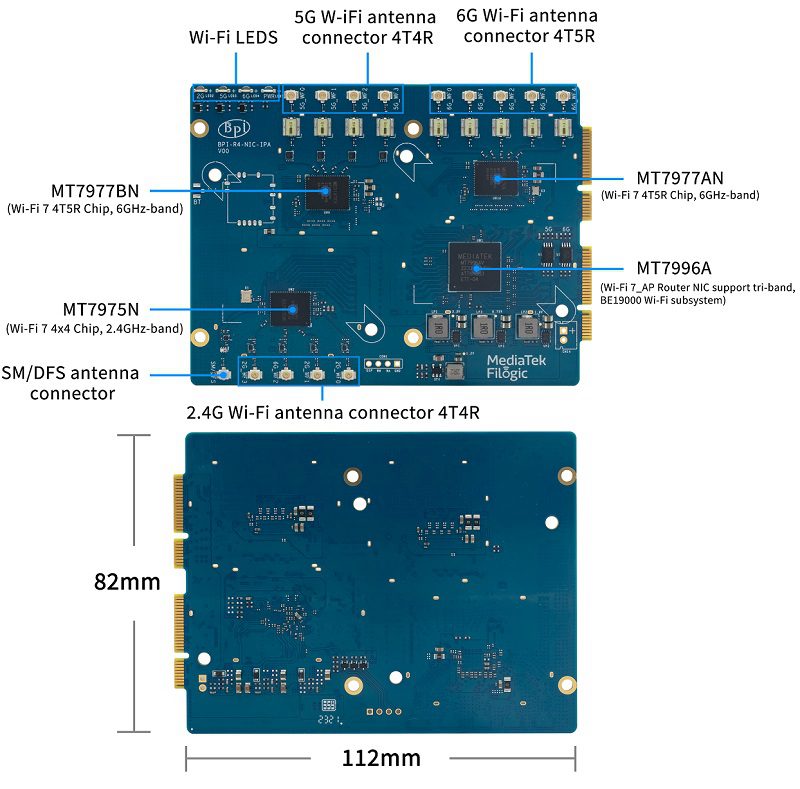Nice ^^ Hope to get it.
Looks like a great board, let us know when we can order.
we do wifi 7 module driver now ,when test it ok , We’ll be mass producing it soon
So for the R4, the WiFi is a plug-in module that takes up two m.2 slots under the board. This is good and bad. The good is that the board is user-replaceable, and can be updated as technologies improve.
The bad news is that this is very poor for thermal considerations. I am very worried about that. It’s already a problem with the R3 - the R3’s m.2 slot on the is also on the bottom of the board. I have experimented with WiFi 6e cards in this location on the R3 and in the end I could not use it in a production environment because it badly overheats.
Wifi7 is likely to generate more heat, and its location under the main board will trap the heat there. The R4 will thus need to have a case where the board is mounted vertically and has ventilation on both sides.
Please, when you come out with the official case, make sure you consider thermal effects.
I’m using Samsung 970 Evo plus nvme drive on BPI-R3 with its metal case.
Its temperature is 50 degrees Celsius idle. And up to 90-92 degrees under load. So, yes, heating can be an issue here.
Try using something like Kingston NV2. The speed is fast enough for R3, and does not get hot. Has low power consumption.
I use it on rk3588 board…
Banana Pi BPI-R4 Wifi 7 router board with MediaTek MT7988A (Filogic 880),4G RAM and 8G eMMC
Nice ^^ Do you have a release date?
+1 to release date as well as release date for WiFi modules
- Is the WiFi daughter board going to ship with the main board?
- I count 14 IPEX connectors in three groups on that daughter board - is there any possibility, since there should be a little more room on a daughter board, to run some signal mixers and combine what I assume are split 2.4/5GHz outputs into single outputs? I really don’t want a router festooned with 12-14 antennae.
Does the built-in MT7530 switch use the full 10G interface? To support concurrent 1G full-duplex on all 4 ports? I know on previous boards this chip was connected at 2500 speed.
The max bandwidth between switch cpu port and first MAC is 4Gbps, so it won’t be limited to 2.5Gbps like BPI-R3.
so the 10Gbit/s are not nearly reached…sfp+ makes so no sense (except it is compatible downwards for sfp) on the p5 of switch as the Bandwidth can be reached using the 4 RJ45 ports. i wonder about that because mt7988 was defined as 3x 10GBit MAC and builtin switch (which is fixed to first mac).
Two SFP are connected to 2nd/3rd MAC via USXGMII interface which can provide 10Gbps. 1st MAC is connected to built-in “5 ports” switch (1 CPU port and 4 LAN ports). The max bandwidth of 4 x 1G port is 4Gbps so 4Gbps bandwidth between switch cpu port and 1st MAC is ok.
ah, forgot that mt7988 has 3 macs, sorry.
Have you tried using sfp modules in the sfp+ slots. Daniel told me that basicly it should be possible.
Have you verified temperature yet? I guess wifi-module and nvme can heat up and because both are located below the main board this can cause problems.
Are cp2102 and ch340 usb2uart adapters working again (r3 has troubles with wifi frontends)? Is maybe the usb-c-port usable as debug-uart (like r2pro)?
Banana Pi BPI-R4 wifi7 module use MediaTek MT7996+MT7995+MT7977A+MT7977B chip design.

What is the difference between mt7977bn and mt7977an? Is BN 5Ghz and there is a typo in the image?
@sinovoip This is primarily aimed at you. I mistakenly replied to SergeS’s post.
Fourteen antennae on one device is going to cause quite a bit of passive mutual interference with significant irregularities in the RF output pattern with possibly severe signal lobing. I suggest you consult with someone who can model that for you. It’s also ungainly to work with - cable routing is going to be a pain.
I recommend that the four 5GHz antenna outputs and the four 2.4GHz antenna outputs be mixed together right on the board. This will give 4 dual-band antenna outputs and 5 dedicated 6GHz antenna outputs. Which is a good mix.
There should be no problem having room on the board for the required RF mixers.
The case should be very carefully designed and should take into consideration:
- Thermal flow of both the main and daughter boards
- Cable routing
- Internal antenna mount points.
- External antenna mounts
For the case I recommend:
- Vertical case design, for thermal flow. Heatsinks can be on both sides on both the main and daughter board, with ventilation bottom and top for air flow
- Plastic case to allow for internal antennae. EDIT: It should be a plastic which has good RF-transparency. ABS and acrylic are both good choices.
- 2-3 internal antennae mounts on the flats of each side (depending on whether you add 2.4/5.8GHz mixers to the daughter board). If you do mix the 2.4/5.8GHz antenna outputs, then 2 internal antenna mounts per side. If you don’t then three per side.
- At least eight external antenna ports - 2 on each narrow side, four along the top.
- Removable panels on the flats of each side for access. EDIT: This is a good place for the RF-transparent acrylic.
My Intel AX210 becomes boiling hot when pulling 880Mbps up or down constantly for 5 minutes or longer, but it does not trigger the overtemp warning (thermal zone also says not detected, so in this instance shorten the lifespan too). So I am not sure what is your use case.
Are you looking for a constant 2.5G stream over the air?